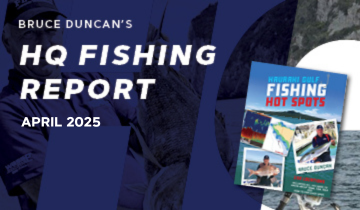Despite the windy cold fronts coming across the Tasman, there have been a few breaks where you could get out on the water for a fishing fix.
Winter fishing this year, I have seen many changes from the norm, we have had more easterly wind and heavy rain than I can ever recall. Having fished the Hauraki Gulf for the last sixty years for me it's not just about catching fish it's more the understanding of what is happening out there so I can help others who don’t know any different. I love seeing the smiling faces of happy kids back at the ramp rather than grumpy disappointed folk.
It's winter and like us, we are not at the beach having barbeques but at home eating stews and it's the same for Snapper. Don’t expect to see many Snapper at your regular summer spots, instead look to where they hang out over winter. Either out wide in deep water or right in close around the rocks reefs and foul. Over winter Snapper feeding habits change due to the fat reserves built up over summer, now they only snack as and when they feel the urge.
Heading out wide can be very hit-and-miss in the winter months, Snapper are more thinly spread as there are fewer workups. Luck does play a part in the deep, I have seen one boat fishing less than two hundred meters from another an catch nothing yet the other managed to catch a few fish. Current can play a big part in where the fish will be, look at the chart and where you see a number of contour lines close together it indicates a steeper drop off. Current increases on the face and bottom edge of the drops offs disturbing the sand exposing shellfish and nutrients but also means Snapper expend more energy feeding.

Deep water fishing has been slow south of Tiri but improves more to the north, from the eastern side of Kawau up to Little Barrier at times have seen good workups with a few whales making a spectacle of themselves.
Habitat is where it’s at, so my preference in winter is to target Snapper close in on the rocks and foul where I know there is a good supply of food which will always hold resident Snapper in the area. Just because the Snapper are living amongst the kelp they will be spread out and it doesn’t mean they will take the bait, you have to tempt them by stimulating their senses by way of burly and ground bait.
Set a game plan to fish the spot over the whole tide, going from spot to spot is a waste of time as the fish will feed at some point. What does change is the manner and way they take the bait. This year more than any Snapper are just mouthing bait, often getting hooked without you knowing you're on. Living in kelp they will eat but not move and it's only when the burly and ground bait kick in and bring more Snapper into the area that will they become competitive grabbing and moving off with the bait.
The inner gulf is fishing well further out around the Noises and bottom end of Waiheke where there has been less of an impact from the recent heavy rain. Area 5 out at the Noises spots 13, 9, and 11 are holding better than average Snapper with the bigger fish taking whole fresh Jack Macs.
Area 7 is at the bottom end of Waiheke, spots 7 and 8 in Routh’s passage fishing in on the foul but spots 17 and 18 are also fishing well where the bottom is flat featureless sand.
Fishing out from Omaha again I have been catching Snapper right in close on the foul at the southern end of the bay just out from the first big house on the cliff. The good news is there are plenty of Jack Macs for fresh bait but also for the John Dory that are lurking about in the kelp.
A warning the area is very shallow and rocky so you don’t need sinkers but be prepared to lose a few hooks. Fishing out from the surf club you will see from the photo, a change in the contour line, as my trails show work slowly in from 12 meters out to around 14. Look for small blue dots (Snapper) and bait fish. Often there will not be a lot of fish showing. The current seems to run to the south most of the time. Cast very lightly weighted baits out at different distances from the boat, and if there is little current without any weight at all. Accu fish is a feature on my sounder that accurately measures the length of any fish that going through the middle of the transducer beam.

Apart from the Kahawai and Kingfish mid-water, you can see a fairly large Snapper plus a few smaller ones close by but, note the number of blue dots that are also snapper on the outer edge of the transducer beam.







